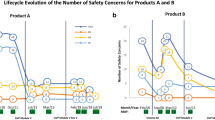Abstract
New European Union (EU) pharmacovigilance legislation, effective from July 2012, introduced new concepts and procedures to optimise the way medicines are regulated within the Union and provided new channels for public health interventions. Triggered by the EU legislation, the work done by the International Conference on Harmonisation (ICH) has provided a common standard for periodic benefit-risk evaluation reporting within the ICH regions. The present paper provides a review of the concepts behind the use of periodic benefit-risk evaluation reports (PBRER) in supporting safety evaluation and assessment of benefit-risk balance and covers essential points in the documentation of safety information, risk evaluation and benefit-risk assessment. The review incorporates the experience to-date with the PBRER at EU level led by the Pharmacovigilance Risk Assessment Committee of the European Medicines Agency. The scope of the PBRER, the main content topics and the challenges relevant to the different stakeholders are highlighted together with key success factors for the report to deliver its objectives and maximise the use of the regulatory assessment procedure. It is clear that the PBRER extends beyond new ways of data presentation and analysis and reflects a further shift in pharmacovigilance in the EU towards more integrated benefit-risk assessment of marketed medicines.






Similar content being viewed by others
Notes
A response to a medicinal product which is noxious and unintended [Directive 2001/83/EC Art 1(11)]. Adverse reactions may arise from use of the product within or outside the terms of the marketing authorisation or from occupational exposure [Directive 2001/83/EC Art 101(1)]. Conditions of use outside the marketing authorisation include off-label use, overdose, misuse, abuse and medication errors [5].
References
International Conference of Harmonisation of Technical Requirements for Registration of Pharmaceuticals for Human Use. ICH harmonised tripartite guideline periodic benefit-risk evaluation report (PBRER) E2C (R2). http://www.ich.org/products/guidelines/efficacy/article/efficacy-guidelines.html. Last accessed 20 July 2014.
International Conference of Harmonisation of Technical Requirements for Registration of Pharmaceuticals for Human Use. E2C(R2) Question and answers: periodic benefit-risk evaluation report. http://www.ich.org/fileadmin/Public_Web_Site/ICH_Products/Guidelines/Efficacy/E2C/E2C_R2_QAs_Step4.pdf. Last accessed 20 July 2014.
Guideline on good pharmacovigilance practices (GVP) Module VII—periodic safety update report (Rev 1). http://www.ema.europa.eu/docs/en_GB/document_library/Scientific_guideline/2013/04/WC500142468.pdf. Last accessed 20 July 2014.
Arlett PR, Kurz X. New approaches to strengthen pharmacovigilance. Drug Discov Today Technol. 2011;8(1):e15–9.
Guideline on good pharmacovigilance practices (GVP) annex I—definitions (Rev 3). http://www.ema.europa.eu/docs/en_GB/document_library/Scientific_guideline/2013/05/WC500143294.pdf. Last accessed 20 July 2014.
List of European Union reference dates and frequency of submission of periodic safety update reports. http://www.ema.europa.eu/ema/index.jsp?curl=pages/includes/document/document_detail.jsp?webContentId=WC500133159&mid=WC0b01ac058009a3dc. Last accessed 20 July 2014.
Commission Implementing Regulation (EU) No 520/2012 of 19 June 2012 on the performance of pharmacovigilance activities provided for in Regulation (EC) No 726/2004 of the European Parliament and of the Council and Directive 2001/83/EC of the European Parliament and of the Council. http://eur-lex.europa.eu/LexUriServ/LexUriServ.do?uri=OJ:L:2012:159:0005:0025:EN:PDF. Last accessed 20 July 2014.
Sabaté M, Pacheco JF, Ballarín E, Ferrer P, Petri H, Hasford J, Schoonen MW, Rottenkolber M, Fortuny J, Laporte JR, Ibáñez L. A compilation of research working groups on drug utilisation across Europe. BMC Res Notes. 2014;13(7):143. doi:10.1186/1756-0500-7-143.
Directive 2001/83/EC of the European Parliament and of the Council of 6 November 2001 on the Community code relating to medicinal products for human use Directive 2010/84/EU of the European parliament and of the council of 15 December 2010 amending, as regards pharmacovigilance.
Arlett P, Sarac SB, Thomson A, Davies C, Teixeira T, Blake KV, Stenver D. The European Medicines Agency’s use of prioritised independent research for best evidence in regulatory action on diclofenac. Pharmacoepidemiol Drug Saf. 2014;23(4):431–4.
Arlett P, Portier G, de Lisa R, Blake K, Wathion N, Dogne J-M, Spooner A, Raine J, Rasi G. Proactively managing the risk of marketed drugs: experience with the EMA Pharmacovigilance Risk Assessment Committee. Nat Rev Drug Discov (Impact Factor: 33.08). 2014;13(5):395–7.
Pharmacovigilance Risk Assessment Committee—Rules of procedure. EMA/PRAC/567515/2012. http://www.ema.europa.eu/docs/en_GB/document_library/Other/2013/03/WC500139609.pdf. Last accessed 20 July 2014.
European Medicines Agency—Work Programme 2014. http://www.ema.europa.eu/docs/en_GB/document_library/Work_programme/2014/03/WC500163394.pdf. Last accessed 20 July 2014.
Prieto Luis, Spooner Almath, Hidalgo-Simon Ana, Rubino Annalisa, Kurz Xavier, Arlett Peter. Evaluation of the effectiveness of risk minimization measures. Pharmacoepidemiol Drug Saf. 2012;21(8):896–9.
Acknowledgments
The authors appreciate the contribution made by Geraldine Portier.
No funding has been received for the preparation of this paper.
Conflict of interest
Peter Arlett, Rodrigo Postigo, Heidi Janssen and Almath Spooner are currently employed by medicines regulatory agencies (European Medicines Agency and Health Products Regulatory Authority) and have been involved in the development of guidelines in relation to the PBRER.
Disclaimer
The views expressed in this article are the personal views of the authors and may not be understood or quoted as being made on behalf of or reflecting the position of the European Medicines Agency or one of its committees or working parties.
Author information
Authors and Affiliations
Corresponding author
Rights and permissions
About this article
Cite this article
Arlett, P., Postigo, R., Janssen, H. et al. Periodic Benefit-Risk Evaluation Report: A European Union Regulatory Perspective. Pharm Med 28, 309–315 (2014). https://doi.org/10.1007/s40290-014-0071-5
Published:
Issue Date:
DOI: https://doi.org/10.1007/s40290-014-0071-5



